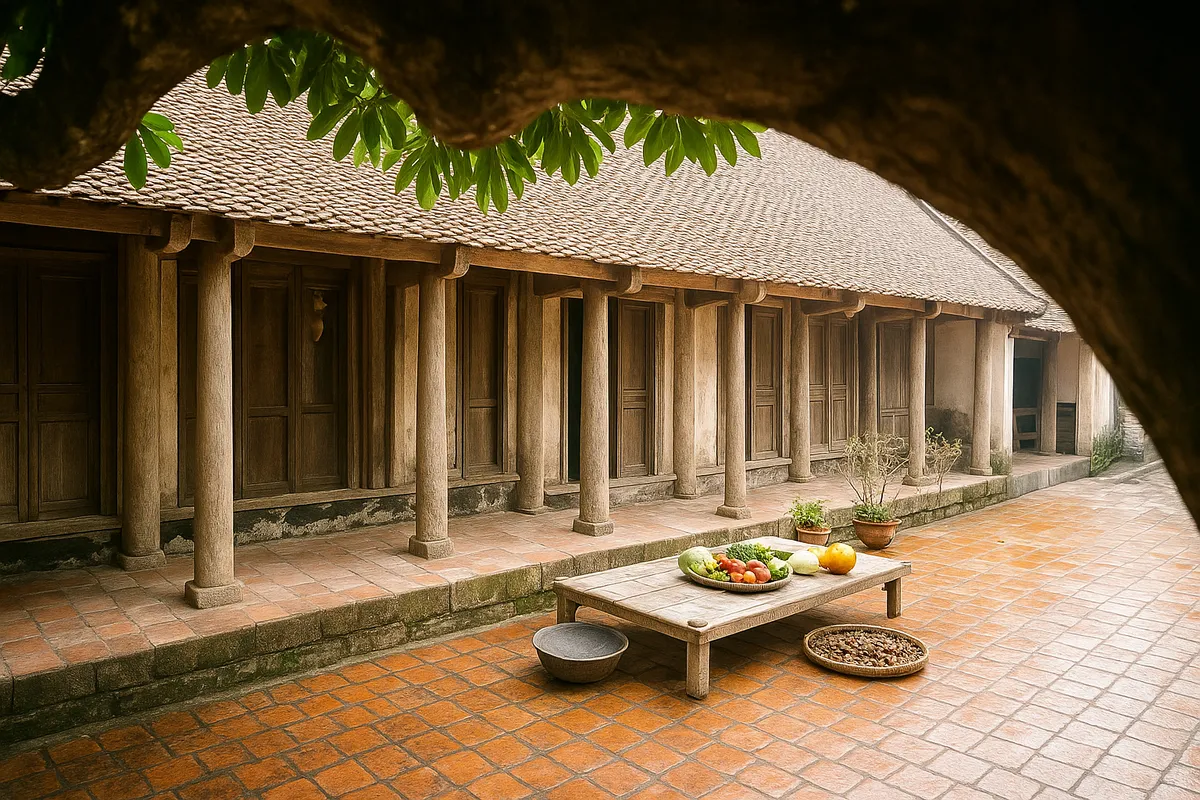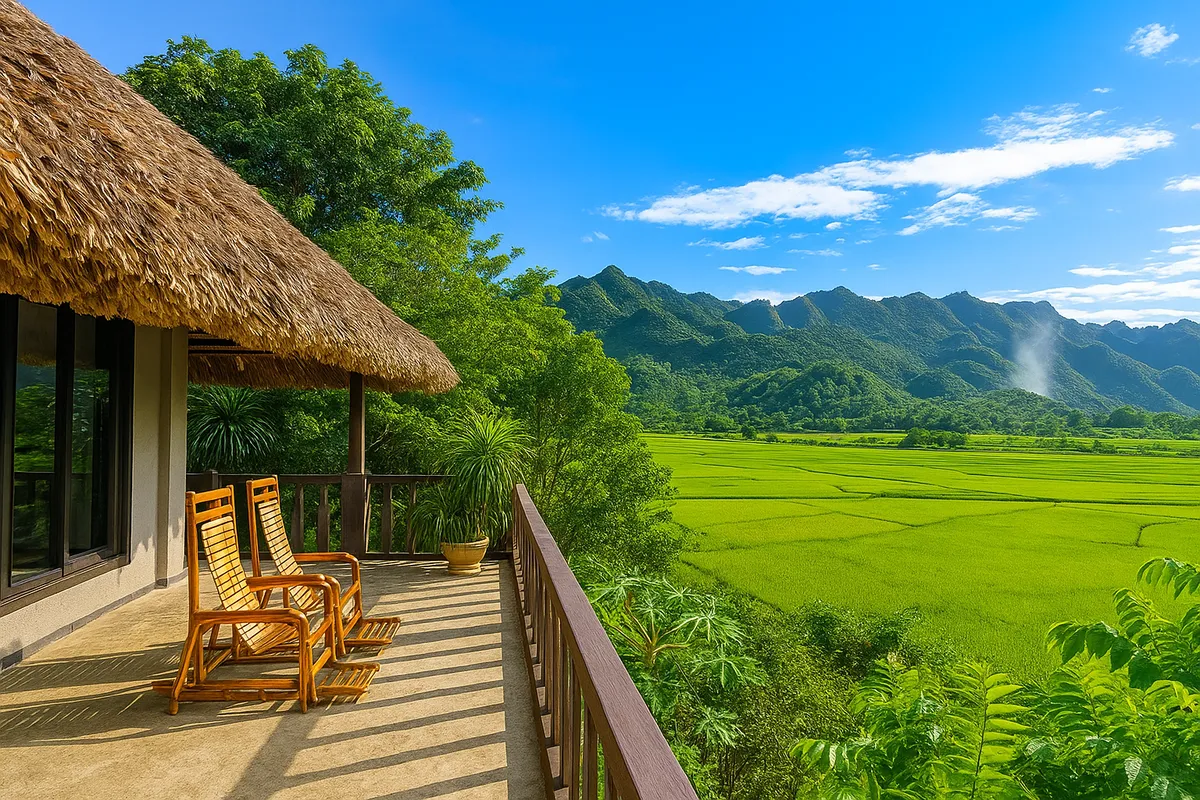Finding ancient Vietnam in Duong Lam ancient village
- Friday, May 09, 2025, 11:40 (GMT+7)
Finding ancient Vietnam in Duong Lam ancient village
Duong Lam ancient village is where time gently lingers on moss-covered laterite walls, where the soul of northern Vietnam still echoes in golden afternoon sunlight, the sound of wooden clogs on old brick paths, and the soft laughter hidden behind low walls of century-old homes. Located just about 50 kilometers from Hanoi, Duong Lam is neither as bustling as the Old Quarter nor as chaotic as the modernizing suburbs. It drifts like an old book someone accidentally opens on a breezy April day, inviting hearts to embark on a journey back through memory.
The entrance to the village has no red carpet or dazzling lights, just a simple charm that mirrors its true beauty. The Mong Phu village gate still stands after countless seasons, its dark ironwood etched with the marks of time. A giant banyan tree casts its shade over an ancient stone well, once the heart of community life. Quiet red-brick lanes wind through hedge fences and rugged laterite walls, enduring and solid like the memories of homeland that never fade.
The space here feels like living in slow motion in a world constantly rushing forward. The faint scent of straw smoke drifts by, roosters crow from lush gardens, and gentle light filters through green leaves, giving the whole village a soothing, indescribable tenderness. Within the village lie more than 800 ancient houses, many over a hundred years old, with tiled roofs aged by moss, ironwood columns, and rustic porches. Behind those weathered wooden doors lives a way of life pure and humble, rich in traditional Vietnamese character, with countryside meals, the scent of green tea, and the rhythmic pounding of young rice in late summer.
Duong Lam is not only beautiful for its nostalgia. It is also the homeland of two national heroes: Phung Hung and Ngo Quyen. One rose up against the Tang dynasty, the other reclaimed independence after a thousand years of foreign rule. Locals still pass down tales of Mong Phu's feng shui, said to be the seat of kings, a land where sacred energies gather. In the village center, Mong Phu communal house stands with quiet majesty, silently witnessing generations of glory. Built in the late seventeenth century from ironwood with traditional tiles, it features intricate carvings of dragons, phoenixes, flowers, and daily life. This space feels both solemn and familiar, like rediscovering something close yet long forgotten.
Mia Pagoda, home to more than 280 statues including the renowned thousand-armed Avalokitesvara, considered one of the most exquisite in the northern plains, is also a must-visit. The lacquered wooden statues, incense-filled altars, and sacred atmosphere invite silence, as if one might disturb the breath of ancestors. Not far away, the temple of scholar Giang Van Minh, once a diplomat under the Ming dynasty, evokes deep pride in Vietnam's ancient wisdom.
Amidst the current of modern life, what sets Duong Lam apart is its preservation of an almost intact ancient village layout, rare in the north. Locals still live in old houses, cook with wood stoves, dry straw in the yard, and spend afternoons sharing family history with their children. Perhaps it is this authenticity that gives the place its soul, no stage setting, no embellishment. Simply sitting on the porch with a cup of green tea, watching sunlight fall on the doorstep, makes the day feel meaningful.
Someone once said, “Duong Lam is where memories return and the heart finds peace in a busy life.” That is what every visitor feels, whether wandering for a morning or staying to watch the sunset over the old communal roof. Here, one can hear time whispering through narrow alleys, in the footsteps on worn bricks, and in the gaze of elders sweeping the front yard each day.
In summer, lychee trees around the village burst with bright red fruit, lighting up the scene with golden sunlight. In winter, mist envelops every path, turning the village into a painting in ink and water. Each season brings a different beauty, but Duong Lam always remains tranquil and poetic. In crisp weather, walking through narrow lanes filled with birdsong, the scent of fresh straw and temple incense blend into a fragrance uniquely nostalgic.
For those planning to visit, the best time is from March to June, when the rice turns golden, the sky is clear, and the sun is gentle enough for roaming without weariness. Getting here from Hanoi is easy by motorbike, car, or bus, taking just over an hour. The road into the village winds through rice fields, sometimes passing herds of buffalo grazing peacefully by the dike.
No visit is complete without tasting the village’s signature rolled roasted pork, seasoned with young guava leaves and grilled slowly over charcoal for hours, yielding crisp, flavorful layers. Free-range Mia chicken is firm and tasty, soft and chewy che lam sweets, and rich traditional soy sauce create a flavorful journey through the rural palate. Many visitors also bring home leaf-wrapped rice cakes, carrying a piece of memory to their loved ones.
Few know that many ancient houses here were built with private wells inside the courtyard, a symbol of abundance and the wisdom of choosing land and preserving water. There is even a persimmon tree said to be over three hundred years old, its gnarled trunk still blooming each season, standing as proof of the village’s resilience through time. Uniquely, Duong Lam was once called the only village in Vietnam recommended by UNESCO to be preserved in its entirety as a living heritage.
Amid glamorous resorts and photogenic check-in spots, Duong Lam appears like an old photograph, no filter, no color correction, yet powerful enough to stir the hearts of those who seek depth and serenity. “There’s nothing special here, just that everything is real,” someone once said and kept quietly returning every year.
And if one day you feel weary of the city, remember that just an hour from Hanoi, there is an ancient village waiting, like a gentle embrace from Mother Earth. Here, time does not pass but soaks into every stone, every breeze, every dream. Here, you need not search for anything grand, just walk quietly, and let your heart settle in this land of memories.

 CHECKIN.VN
CHECKIN.VN








Share on